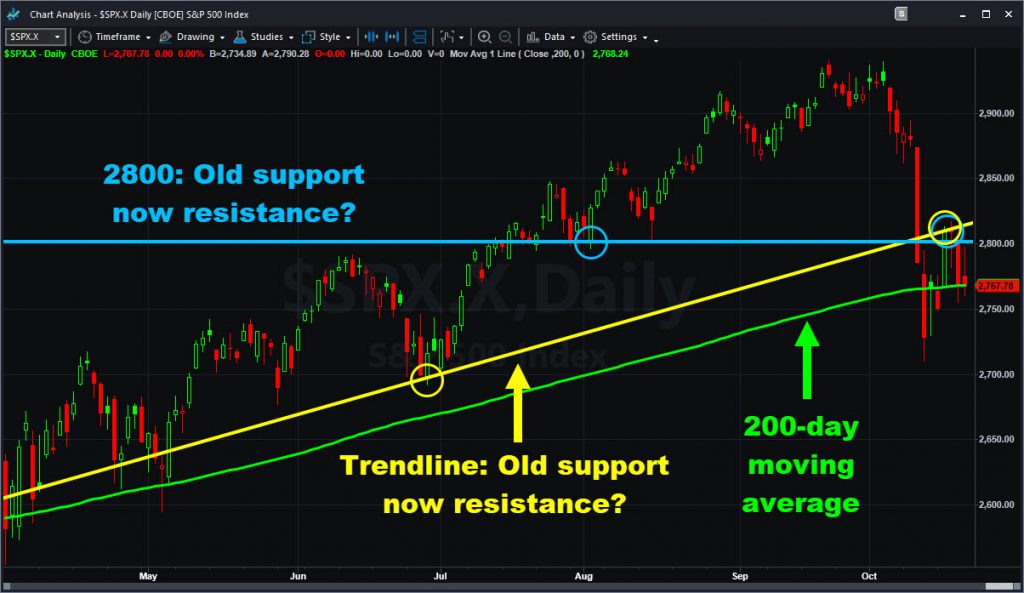Stocks are trying to hold their ground after a brutal volatility shock earlier this month.
The S&P 500 rose less than 0.1 percent between Friday, October 12, and Friday, October 19 — its first gain in three weeks. The index is still down more than 5 percent since the end of September.
The Nasdaq’s fared even worse, down almost 7 percent over the same period. Depending on how you measure it, we’re looking one of the most bearish months in several years for key indexes.
A lot of attention has focused on the Nasdaq because of struggling growth names like Amazon.com (AMZN) and Netflix (NFLX). Investors were willing to stomach their rich multiples when interest rates were lower, but now a hawkish Federal Reserve is hurting sentiment.
Other areas of the market struggled, especially “risk-on” sectors that benefit from a strong economy. Industrials, for instance, declined on several poor earnings reports. Some blamed higher costs from President Trump’s tariffs against China.
Consumer discretionaries also took a beating as investors sold retailers before the holidays. Energy was the worst major sector, down 2 percent, as crude oil inventories continued to build.
That’s not all the red ink: Chinese Internet stocks continued to slide as the Asian giant’s economy struggled. Homebuilders crumbled as higher rates depressed home sales.
The biggest gainers last week were so-called “safe havens”: Consumer staples rose 4 percent, while real-estate investment trusts and utilities advanced 3 percent.
The economic news wasn’t too inspiring. Sure, labor metrics like unemployment claims and job openings remained very strong. But retail sales, housing starts, building permits and existing home sales all missed estimates. We’ll also keep an eye on the apparent slowdown in rail traffic.

Getting back to the S&P 500, chart watchers may spot a few negative patterns. First, the index is at risk of breaking its 200-day moving average. Second, it seems to be consolidating below a long-term trend line. Third, the same 2800 level that was support in August may have become resistance.
Advertising agencies were the biggest gainers in the S&P 500 last week. Interpublic Group rose 15 percent and Omnicom (OMC) climbed 12 percent. Both reported better-than-expected earnings and strong organic revenue growth. Consumer-goods giant Procter & Gamble (PG) also surged 11 percent thanks to price increases and gains in beauty products like Olay.
United Rentals (URI) led to the downside, dropping 15 percent on a lowered free cash-flow outlook. Valero Energy (VLO) also cratered 14 percent after Goldman Sachs predicted narrower oil-refining margins and the company paid a premium to acquire a related firm.
This week is packed with corporate earnings and some important economic events.
Today brings results from Halliburton (HAL), Hasbro (HAS) and Kimberly Clarke (KMB).
Tomorrow’s big names includes Dow Jones Industrial Average members like Caterpillar (CAT), McDonald’s (MCD), 3M (MMM) and United Technologies (UTX).
Wednesday has new-home sales, crude-oil inventories and the Federal Reserve’s Beige Book survey of economic conditions. Microsoft (MSFT), Boeing (BA), Advanced Micro Devices (AMD) and United Parcel Service (UPS) lead the reporting lineup.
Thursday’s the busiest session of earnings season, with roughly 260 companies issuing results. There are big tech names like Amazon.com (AMZN) and Alphabet (GOOGL), drug stocks like Merck (MRK), Celgene (CELG) and Biogen (BIIB) and industrials like Raytheon (RTN), Union Pacific (UNP) and Southwest Airlines (LUV).
On top of those numbers, Thursday also brings a rate decision by the European Central Bank, U.S. durable-goods orders, and initial jobless claims.
Friday’s big event is the Commerce Department’s initial reading of third-quarter gross domestic product. Consumer sentiment is due as well.
Brazil may also be in focus over the course of the week with presidential elections scheduled for Sunday, October 28.






















